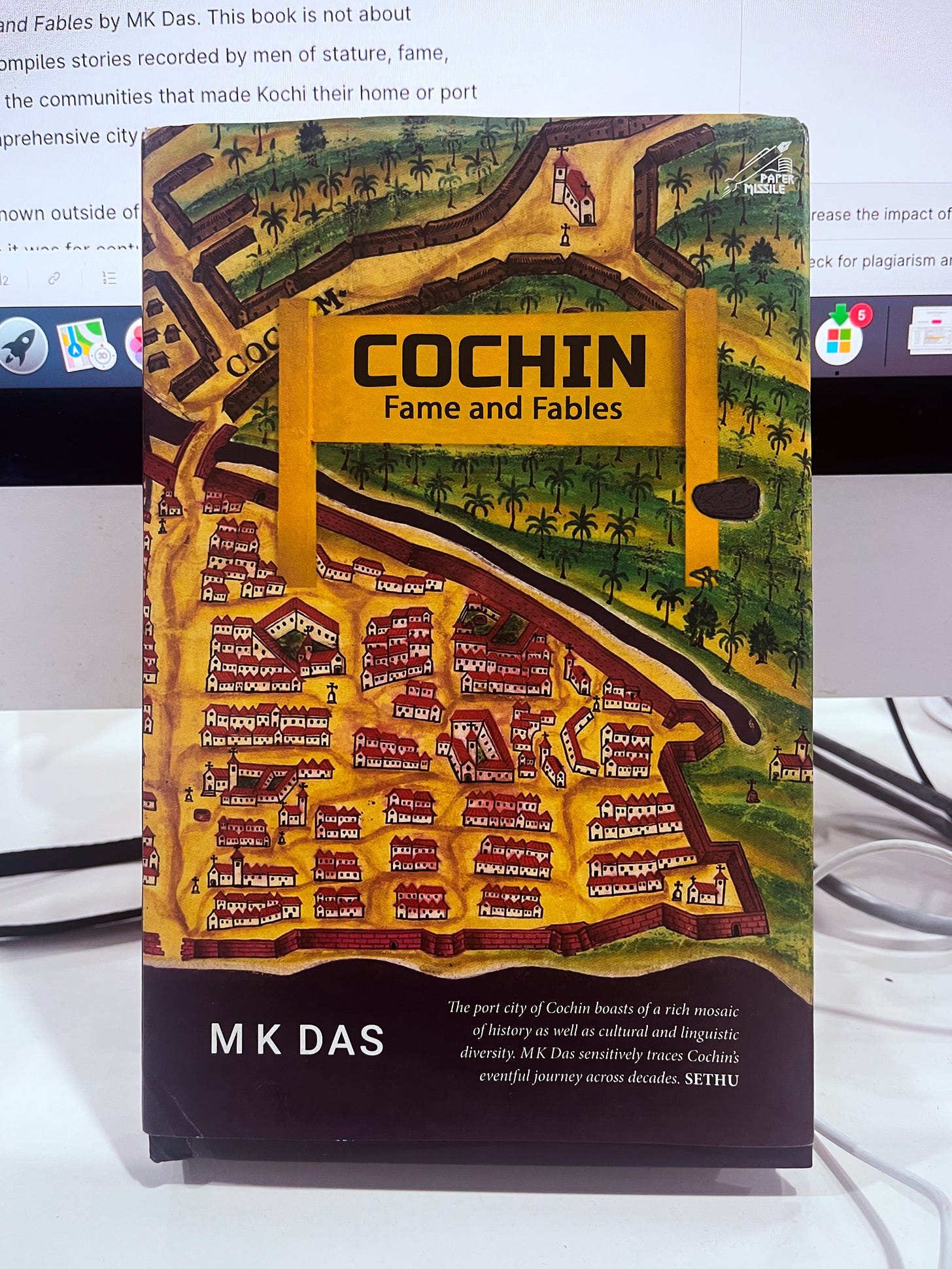Book: Cochin-Fame and Fables
Author: MK Das
Publisher: Niyogi Books
The world's greatest cities are built on stories. They are likely home to several storytellers and have been fortunate enough to host visitors who found them interesting enough to record their brief interactions. Their words add up, and great cities are formed in our collective imagination over time.
I am not sure if Kochi or Cochin has an Orhan Pamuk. The only book I have read from Kochi (Cochin) is Lanthan Batheriyile Luthiniyakal (Litanies of the Dutch Battery) by NS Madhavan. I listened to the Malayalam version of that book and enjoyed the story immensely. It beautifully brings to life the city of Kochi and its surroundings in the middle of the last century through the eyes of ordinary people.
That period is also extensively covered in the book I am writing about today—Cochin Fame and Fables by MK Das. However, this book is not about ordinary people but compiles stories recorded by men of stature, fame, and fables, as well as the communities that made Kochi their home or port of call, forming a comprehensive city biography.
Kochi is not widely known outside of the Malayalam-speaking world as a princely state, which it was for centuries before becoming part of the united state of Kerala and the Indian Union. Due to this heritage, Kochi's history is likely better documented, providing the information required for a book of this length, breadth, and depth.
The Origin Story
A great flood of the Periyar River in 1341 created the geography of what we now call Cochin or Kochi. The author also refers to it as a tsunami rather than a flood in several places which I found confusing. The river changed course because of that event. It destroyed a thriving trading port called Muziris, located north of present-day Kochi, creating sandbars and islands suitable for a port connecting to the spice-growing regions inland. Over time, trading activities took root here, attracting communities from across the Arabian Sea who likely traded with Muziris and other ports along the coast.
Fame and Fables
Historically, Kochi served as the centre of a relatively small kingdom that actively engaged with trade routes across the Arabian Sea and Indian Ocean. A network of canals and a limited number of roads connected it to its fertile hinterland, rich in rice, spices, and coconuts. A thin strip of sand, formed by natural floods and later settled by inhabitants, has become integral to its identity. Das's book documents the kingdom's history and evolution into a commercial hub in independent India, all presented in accessible language.
Colonial History
Although Portuguese explorer Vasco da Gama landed near Kozhikode (Calicut) when he made his way to India, it was in Kochi and later Goa that they laid the foundation for their colonies. The twists and turns of relations between Europeans, other trading communities, and the kingdom of Cochin form a significant part of the book. The Portuguese were replaced by Dutch colonisers and traders, who the British subsequently dislodged. We learn from records and fables that Kochi is not solely a British colonial creation like Mumbai (Bombay) or Chennai (Madras). Kochi was not built in a day; instead, its brick-by-brick formation by different communities is one of the most insightful aspects of Das's narrative. The chapters "Royal Visionaries" and "Decisive Dewans" detail the kingdom's role.
In India, communities come together and make cities what they are. Kochi is no different. The book has the recorded histories and fables from the major communities that the ocean and inland trade routes brought them here. The Arabs, Konkani speakers from the coast to the North escaping from the Portuguese, communities from Gujarat and Kutch who have always been an integral part of the Indian Ocean trade, and the Tamil speakers from the east, to name a few. Readers from Kerala will find the politics of Kerala's central rulers and local chieftains throughout the existence of the city quite interesting.
Kochi Post-Independence
One of the most significant stories of our time is the growth of cities driven by unprecedented migration from villages and small towns to metropolises across the subcontinent. The urbanisation of Kerala presents a unique narrative. Visitors to this state or along the coast extending to Goa will find it characterised by endless urban sprawl. Within this sprawl, Kochi stands out as the state's commercial capital, and this book is for those interested in understanding how it achieved this status.
If you like cities or from Kochi, this book is a must-have on your bookshelf. It seems to be an easily accessible compilation of stories, fables and facts.
Cochin International Airport








I bought my copy from Trivandrum last week. Thanks for the recco. Beautiful cover.
I’ll be visiting Kochi in early January for a climate solutions residency. I’ve been once before for the Biennale. I’d like to experience the city from the perspectives of its people!